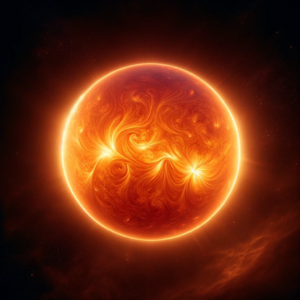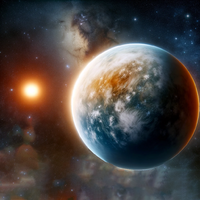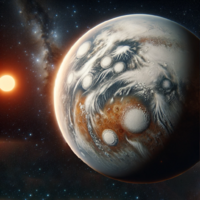
| Type: | K1 V Orange Main Sequence |
| Radius: | 6.74 x 105 km (0.97 of Sol) |
| Mass: | 1.98 x 1030 kg (Similar to Sol) |
| Temperature: | 4700 K |
| Luminosity: | 1.58 x 1026 W (0.41 of Sol) |
| Ecosphere: | 0.65 and 0.94 AU |
| Location: | 3.9 ly from the Bone Nebula Sumutlis Sector |
In the Epsilon Cuminiar Star System, Nebuloniar and Vorania stand out as the twin jewels capable of supporting humanoid life, orbiting a K1 V Orange Main Sequence star. Nebuloniar, with its Earth-like temperature and pressure, hosts the ominous military base, Shadowspire, and is distinguished by its dense, mildly toxic atmosphere and the enchanting, luminescent fogs that blanket its nights. The planet's surface, rich in water and ice, harbors prokaryotic life forms, contributing to a landscape that is as beautiful as it is mysterious. In contrast, Vorania, a world with an Earth-similar atmosphere but significantly colder, presents a stark landscape of glaciers and permafrost. It's marked by intriguing sub-glacial tunnels, possibly hinting at ancient civilizations, and a vibrant ecosystem of extremophile organisms thriving near the equator.
Zypheron
| Class: | C |
| Distance: | 0.42 AU |
| Period: | 99.58 Days |
| Radius: | 1633.33 km |
| Gravity: | 0.08 G |
This planet has 2 asteroidal moons (Lyrathos and Eclionis) in elliptical orbits, both are class D and have a radius around 120 km. The surface has no atmosphere, with a mean surface temperature of 186 C. Notably, Zypheron features an extensive network of deep canyons and valleys that emit sporadic, intense radio signals of unknown origin. These signals, which vary in frequency and duration.

Nebuloniar
| Class: | M |
| Distance: | 0.67 AU |
| Period: | 200 Days |
| Radius: | 8146.69 km |
| Gravity: | 1.31 G |
Onyx maintains a military facility on this planet called the Shadowspire. The planet has prokaryotic microbes and a dense atmosphere that is mildly toxic with about 7ppm of Sulfur Dioxide in the atmosphere on average. The surface is 28% water, with 22% of that being ice, mostly located at the ice caps. The average surface temperature and pressure are similar to Earth, although tend to be slightly colder. Intriguingly, Nebuloniar is known for its luminous nocturnal fog that appears unpredictably in various regions. This fog exhibits an unusual luminescence, glowing with a spectrum of colors, and is believed to be a result of unique photochemical reactions involving the planet's native microbes and atmospheric composition.

Vorania
| Class: | L |
| Distance: | 0.92 AU |
| Period: | 323.33 Days |
| Radius: | 6920.23 km |
| Gravity: | 1.11 G |
Similar to Earth in atmosphere, the planet is much colder than its neighbor Nebuloniar. Average surface pressure is 0.83 atm (84 kPa) with a mean surface temperature of -29 C. The planet surface is largely covered in glaciers and permafrost, though there are more temperate regions near the equator. There is a diverse biome of temperature-resistant bacteria and other single-celled organisms, mainly near the equator, along with various forms of bioluminescent algae that survive in a sub-surface layer of liquid water. A unique feature of Vorania is the presence of vast, mysterious sub-glacial tunnels, whose origins are unknown. These tunnels, some large enough to house entire cities, display intricate patterns on their walls, resembling ancient carvings or natural formations.
Eridos
| Class: | P |
| Distance: | 1.58 AU |
| Period: | 725 Days |
| Radius: | 7768.85 km |
| Gravity: | 1.25 G |
This world has a relatively thin atmosphere, with an average surface pressure of 40.4 kPa (0.40 atm) composed mostly of Oxygen, Hydrogen, and Helium. The atmosphere is hazardous due to it being about 70% oxygen and thus is highly oxidizing. The planet's atmosphere is extremely volatile because of the high concentration of Oxygen and Hydrogen and any ignition of the atmosphere could cause a catastrophic chain reaction. Naturally, the planet's atmosphere is stabilized by the cold temperatures, which average to -87 C across the surface. Eridos is home to a unique aurora effect, these are vibrant auroral displays that are far more intense and varied in color than those on Earth, occurring even during the planet's daylight hours. These auroras are a result of the planet's highly reactive atmosphere interacting with solar winds. The phenomenon not only creates stunning visual displays but also emits a low, humming sound that can be heard on the surface, adding an auditory dimension to the spectacle.
Crythia
| Class: | C |
| Distance: | 2.64 AU |
| Period: | 1412.50 Days |
| Radius: | 1293.95 km |
| Gravity: | 0.06 G |
This world is a cold and barren planet with no atmosphere, the average surface temperature is -129 C, and it is composed mostly of various carbon substances such as Basalt, Tar, and Bitumen. A striking feature of Crythia is its vast, labyrinthine network of natural underground caves filled with sparkling, crystalline structures. These caves contain a variety of unique crystals and minerals that emit a faint, pulsating light, creating a surreal, otherworldly underground landscape. Some of these crystals have unique properties, exhibiting unusual magnetic or electric responses, leading to speculation about their potential uses in technology or as energy sources.